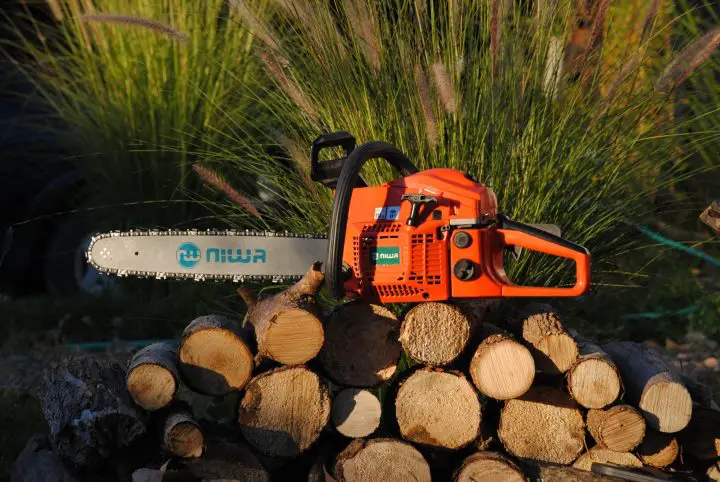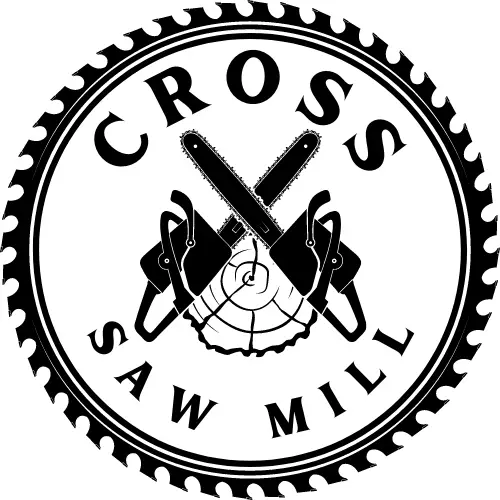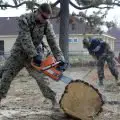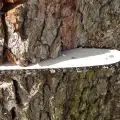If your chainsaw isn’t cutting wood as quickly and easily as it should be, despite your best efforts, you might want to consider porting it. Its lifespan will be extended in addition to its power being increased by doing this.
In this article, we’ll discuss all you need to know about porting a chainsaw so that you can make the necessary adjustments to reach optimum chainsaw engine performance.
Table of Contents
- What Does Chainsaw Porting Mean?
- Benefits & Drawbacks of Porting a Chainsaw
- Preparation Before Porting a Chainsaw
- How to Port a Chainsaw
- Other Methods of Porting
- Risks of Porting a Chainsaw
- Chainsaw Porting Mistakes to Avoid
- Tips for Chainsaw Porting Success
- Porting a Chainsaw Yourself vs Hiring a Professional
- FAQs (Frequently Asked Questions)

What Does Chainsaw Porting Mean?
The technique of porting improves airflow and prevents clogging by removing material from the muffler’s interior. The intake and exhaust ports of a chainsaw engine should be expanded and modified. Its performance is enhanced and its power output is increased. Porting can be carried out manually using files and grinders or using specialist equipment.
The procedure can raise the power output of chainsaws by 20%, improving their ability to cut through dense timber. The engine’s lifespan can be increased through porting too, which ultimately increases fuel efficiency and help it run cooler.
Sawdust and other debris can quickly jam the tools, which reduces their effectiveness and power. Regular porting will keep your chainsaw in peak shape.
A chainsaw is a crucial piece of equipment for any woodworker. They are useful for tasks like pruning branches and tree cutting. But if they are not maintained properly, chainsaws can be a little problematic.
On the topic of maintenance, visit our Chainsaw Bar Upkeep and Maintenance guide for more information!
Benefits & Drawbacks of Porting a Chainsaw
One kind of saw modification that is offered is porting. Port timing tweaks, a new carburetor, and a modified stock cylinder shape are among these modifications. You will obtain greater performance in terms of gas mileage and decreased emissions if you port a chainsaw.
Following the procedure, you can benefit from these perks:
- The curves, torque, power, and reaction time of the chainsaw are affected by the higher compression ratios since they provide more output and efficiency.
- A lower operating temperature results in less wear or abuse and a longer lifespan.
Nevertheless, there are risks associated with porting your own saw. For instance, it can void any equipment warranties you may have.
Additionally, if done poorly, it could harm or even completely destroy some components of the engine, necessitating expensive repairs or the purchase of replacement pieces for your machine.
Make sure you are capable if you decide to do it yourself.
Preparation Before Porting a Chainsaw
Required Tools and PPE
- Wrenches
- Manual file (metal)
- Grinders for opening muffler
- Pneumatic drill
- Screwdriver
- Manual bits and file bit
- Measuring gauge and marker pen
- Cloth for cleaning oil
Protective Equipment
- Eye protection
- Gloves (provide better grip)
- Mechanical apron
Preparation
At the porting area, separate the chainsaw’s cylinder base and gas or oil tank to begin disassembling it. Get rid of the chainsaw chain bar. However, use care when disassembling anything. To remove grease, dry-wipe the cylinder wall next. Record the engine’s precise measurements in writing.
How to Port a Chainsaw
1. Widen the Exhaust
The gateway to accessing the inside part of the chainsaw is through the exhaust path. Connect the air compressor to the muffler’s exhaust port, then insert the airline. You should open the regulator on the compressor to the desired setting (experts typically increase it to 25 PSI), and it will deliver a blast of compressed air to the chainsaw. You can pressurize the muffler using an air-powered drill.
TIP: You can use an electric Dremel to prevent the exhaust system valve from being shot open suddenly and forcefully. To reduce the height of the chainsaw jug, you will also engage in squishing. The process you’ll use together with the thin gasket is called milling.
2. Remove the Muffler Exhaust Holes
Create some space inside the intake and exhaust system. Eliminate the exhaust ports on the muffler, leaving the compressor connected to the gas chainsaw. The CAT muffler may be removed to see every hole. Continue sawing after that until all of the metal has been taken out.
TIP: Turn off the compressor and give it at least 30 minutes to cool. It makes moving on to the next stage simple for you.
3. Attach the Muffler Top
Install the muffler cap (half portion) cautiously and firmly when the chainsaw has cooled down.
TIP: You can insert sealant gum into the holes you just created and wait for it to set.
4. Drill a Hole in the Muffler
Make a vent in the muffler of the vehicle. If you must hole, try to avoid doing it too deeply or at an odd angle. Use a power drill to create a clear, precise hole for the exhaust.
5. Polish the Holes
After drilling and sawing, use a metal file to smooth everything out and eliminate extra material. Check the chainsaw’s compression ratio by putting it to the test with the gas engine. For a more polished appearance, try painting and sanding the parts.
More information on files in our Chainsaw Chain File Sizes Chart guide!
Other Methods of Porting
Alternatives to the traditional strategy produce comparable outcomes. One approach is to fill the combustion chamber of the saw with sawdust. The saw’s combustion ratio will consequently rise, enabling it to make more power cuts.
The method’s primary goal is to lower the operating temperature of the chainsaw. Wood porting is an unconventional technique. Therefore, to prevent unneeded corrosion, a high level of competence is needed.
You shouldn’t try to do this technique to improve the chainsaw’s performance if you’re just starting off with these box-practice routines. In addition to porting a chainsaw, the following modest changes can also help increase power:
- The transmission ports of the compressor can be further adjusted using the majority of power tools.
- On the pistons, the exhaust ports can be polished.
- Remove the RPM limiting coil or replace it with an unrestricted coil.
- You can change the mechanical timing of the transfer ports on the chainsaw model by polishing and honing them.
- You should take out any extraneous components to make the piston lighter.
Risks of Porting a Chainsaw
The ports need to be treated with the utmost care because they are essential to using a typical chainsaw. Many YouTube channels cover various chainsaw porting techniques, but you can also consult a local expert or professional.
Sadly, not everyone is cautious when attempting to increase compression. They enable the exhaust ports to be so big that the exhaust system’s ring may get caught in them.
Incorrectly porting chainsaw engines may lead to experiencing some engine speed or power loss, and in severe circumstances, may become useless. This essentially means that it won’t have as much power and that cutting wood will be more difficult. Spend some time learning about your saw’s engine if you want it to have additional power.
When porting a chainsaw, people frequently remove a substantial portion of the piston crown or engine cylinder edge to make room for the piston ports. As a result, it experiences consequences and degrades. As a result, sometimes it is not worth porting chainsaws.
Chainsaw Porting Mistakes to Avoid
While porting can significantly enhance the performance of a chainsaw, it’s a delicate process that requires a good understanding of small engine mechanics. Mistakes can lead to decreased performance, increased wear and tear, or even engine failure.
1. Removing Too Much Material
- Issue: Overzealous material removal can weaken the engine’s structure, alter port timing unfavorably, and lead to leaks or breaks.
- Avoidance: Use a conservative approach. Remove material gradually and measure frequently to maintain structural integrity and desired port specifications.
2. Ignoring Port Timing
- Issue: Changes in port timing can drastically affect engine performance. Incorrect timing can lead to lower power output, poor fuel efficiency, or engine damage.
- Avoidance: Understand the specific timing needs of your chainsaw’s engine and adjust ports carefully to maintain or improve timing. Use precise tools and gauges to measure changes.
3. Neglecting to Smooth Ports Properly
- Issue: Rough or improperly finished ports can disrupt airflow, reducing the efficiency of the modifications. Sharp edges can also lead to premature wear and tear.
- Avoidance: After modifying ports, use fine tools to smooth out the surfaces and remove any burrs or sharp edges. Aim for a polished finish to ensure optimal airflow.
4. Not Rejetting the Carburetor
- Issue: Porting increases the airflow through the engine, which can alter the air-fuel mixture. Without rejetting, the engine may run too lean or too rich, affecting performance and longevity.
- Avoidance: After porting, adjust the carburetor settings or change the jets to ensure the engine receives the correct air-fuel mixture for optimal performance.
5. Using Incorrect Tools
- Issue: Using inappropriate tools can lead to uneven port modifications, accidental damage to the engine, or suboptimal port shapes.
- Avoidance: Use the right tools for the job, such as high-quality rotary tools, files, and gauges designed for precision work on small engines.
6. Failing to Test and Adjust
- Issue: Assuming porting modifications will be perfect on the first try is optimistic. Without testing and adjustments, the engine may not perform as expected.
- Avoidance: After porting, thoroughly test the chainsaw under controlled conditions. Be prepared to make adjustments to the ports, carburetor, and ignition timing as needed.
7. Overlooking Safety and Reliability
- Issue: Excessive modifications can make the chainsaw unsafe or unreliable. High-performance engines may require more maintenance and can have a shorter lifespan.
- Avoidance: Balance performance enhancements with the intended use of the chainsaw, keeping safety and reliability in mind. Consider the increased maintenance requirements and potential impacts on durability.
8. Ignoring Manufacturer’s Specifications and Warranties
- Issue: Porting can void warranties and, if done incorrectly, can lead to engine damage that won’t be covered by the manufacturer.
- Avoidance: Be aware of the warranty implications and consider whether the performance gains are worth the risk. Keep in mind the specifications set by the manufacturer as a guideline for safe modifications.
Tips for Chainsaw Porting Success
When done correctly, porting can significantly enhance the performance of your chainsaw by improving airflow and increasing power output.
Here are some tips for achieving success in chainsaw porting:
1. Educate Yourself
- Understand the Basics: Before starting, make sure you have a solid understanding of two-stroke engine operation, including how changes to port shapes, sizes, and timings can affect performance.
- Research and Resources: Utilize online forums, tutorials, and guides specific to chainsaw porting. Many experienced porters share their knowledge, which can be invaluable.
2. Start with the Right Tools
- High-quality rotary tools, files, and carbide burrs are essential for precise material removal and shaping.
- Invest in accurate measuring tools like calipers and degree wheels to measure port timings and dimensions accurately.
3. Plan Your Work
- Set Clear Goals: Know what you want to achieve with porting, such as more torque, higher RPMs, or better throttle response.
- Map Out Ports: Use diagrams and sketches to plan your modifications. This helps in maintaining symmetry between ports and ensuring you only remove necessary material.
4. Measure Twice, Cut Once
- Carefully measure the existing port dimensions and engine timings before making any changes.
- Small, incremental changes are key. It’s easier to remove more material later than to add it back if you’ve removed too much.
5. Focus on Port Shapes and Finishes
- Smooth and even port surfaces facilitate better airflow. After removing material, ensure ports are smoothly finished, removing any burrs or sharp edges.
- Pay attention to the shape of the ports. The aim is to guide the air-fuel mixture efficiently, not just to increase the size of the ports.
6. Adjust Fuel Mixture and Ignition Timing
- After porting, the engine will require adjustments to the carburetor settings to ensure an optimal air-fuel mixture.
- Ignition timing may also need tweaking to match the engine’s new performance characteristics.
7. Test and Tune
- Initial testing should be done in a controlled environment. Monitor engine temperature, performance, and responsiveness.
- Be prepared to make further adjustments based on test results. Porting is often a process of trial and error to find the best setup for your specific needs.
8. Maintain Engine Health
- After porting, regular maintenance becomes even more crucial. High-performance engines can be more demanding, requiring frequent checks and adjustments.
- Monitor for signs of wear or issues, as ported engines may experience different stress patterns compared to stock configurations.
9. Learn from the Community
- Engage with the chainsaw porting community. Sharing your experiences and learning from others can provide new insights and techniques.
- Constructive feedback from experienced porters can help refine your skills.
10. Practice on Spare Engines
- If possible, practice your porting techniques on spare engines or cylinders before attempting modifications on your primary chainsaw. This can help build your skills without the risk of damaging your main equipment.
Porting a Chainsaw Yourself vs Hiring a Professional
It can be fairly easy to port a chainsaw. However, it is crucial to emphasize that only skilled mechanics or experts should attempt it. Engine damage and lower performance can result from improper porting.
Perhaps you prefer to do things yourself or are only trying to save money. If you’re thinking about porting your chainsaw, you should be aware of a few things before beginning.
The first thing to consider is if you have the abilities and expertise required to do the task successfully. It’s generally advisable to employ someone who can execute the task properly if you’re unsure about your ability to do it.
Cost is another factor to take into account. It will be more expensive to hire someone to port your chainsaw than to do it yourself. But if you’re unsure of your capabilities, it’s usually worth the extra money.
You must make a decision regarding the type of exhaust port you choose. The two fundamental varieties of pots are standard and bespoke. Although standard ports are more affordable and simpler to install, they are not always the ideal choice for every Chainsaw. Custom ports, on the other hand, are more expensive and challenging to set up. Nevertheless, they provide a unique look and feel.
Regardless of how talented or well-regarded the mechanics may be, wood porting services are never reliable, even if supplied for a reasonable fee. It’s crucial to take your time and do your research when choosing a technician if you want quality work and greater performance.
As a chainsaw owner, you must be aware that the advantages of this method depend on how skilled the builder is. Try to avoid falling for the hype. The hype alone won’t make a builder an expert at wood porting. It typically takes a long time to respond. It often takes six to eight weeks, although it might also take many months.
Most chainsaw owners simply take their saw to a technician who wood ports without doing any study when they want to “upgrade” from the conventional saw to a brand-new one. The price of wood porting might be $500. It’s expensive, and you might not even get what you pay for if you don’t choose the “right” mechanic.
Here is a multi-part series on YouTube to follow:
FAQs (Frequently Asked Questions)
How can I get more power out of my chainsaw?
It is feasible to modify a chainsaw to boost its power, but you should proceed with caution. The most popular techniques include changing the muffler to increase airflow through the engine, removing the muffler to measure it, enhancing exhaust outlet flow and tweaking the carburetor, and opening and polishing the cylinder ports, transfer ports, and muffler. It’s crucial to remember that certain modifications might violate warranties.
How to port and polish a chainsaw?
You must disassemble the chainsaw and remove the cylinder and piston before you can port and polish it. The apertures in the cylinder can be polished and smoothed using a die grinder or a Dremel tool after the cylinder head shape has been removed. This will aid in boosting airflow and enhancing the chainsaw’s functionality. The surface of the cylinder and piston can also be smoothed with a honing stone. If you are not at ease with the procedure, you should think about hiring a professional.
How much does it cost to port a chainsaw?
You might have to pay $40 to have the cylinder cut at the machine shop. You still have four hours of work to do. Obtaining port timing data and performing porting requires this time. Depending on the requirements, the standard fee for the service ranges from $100 to $300.






